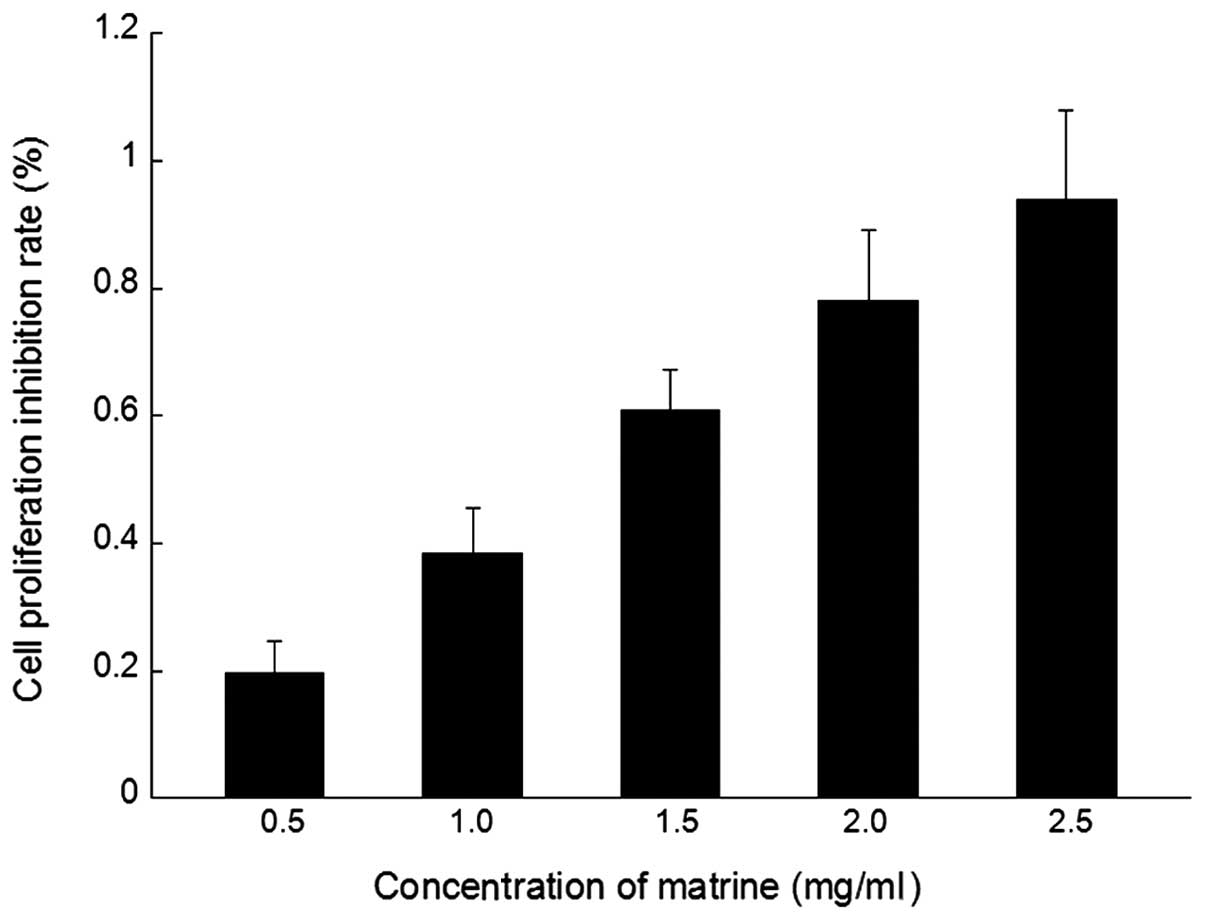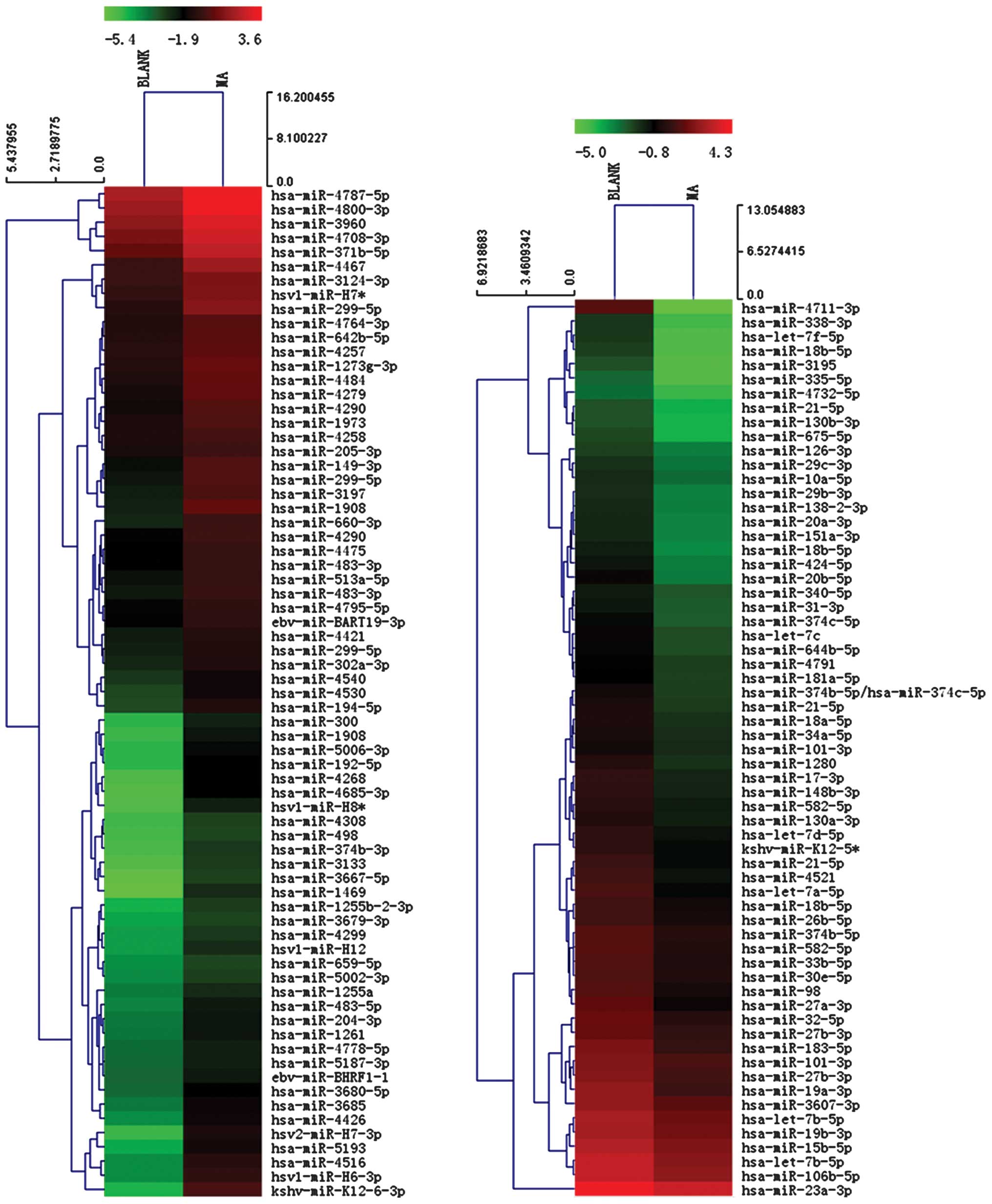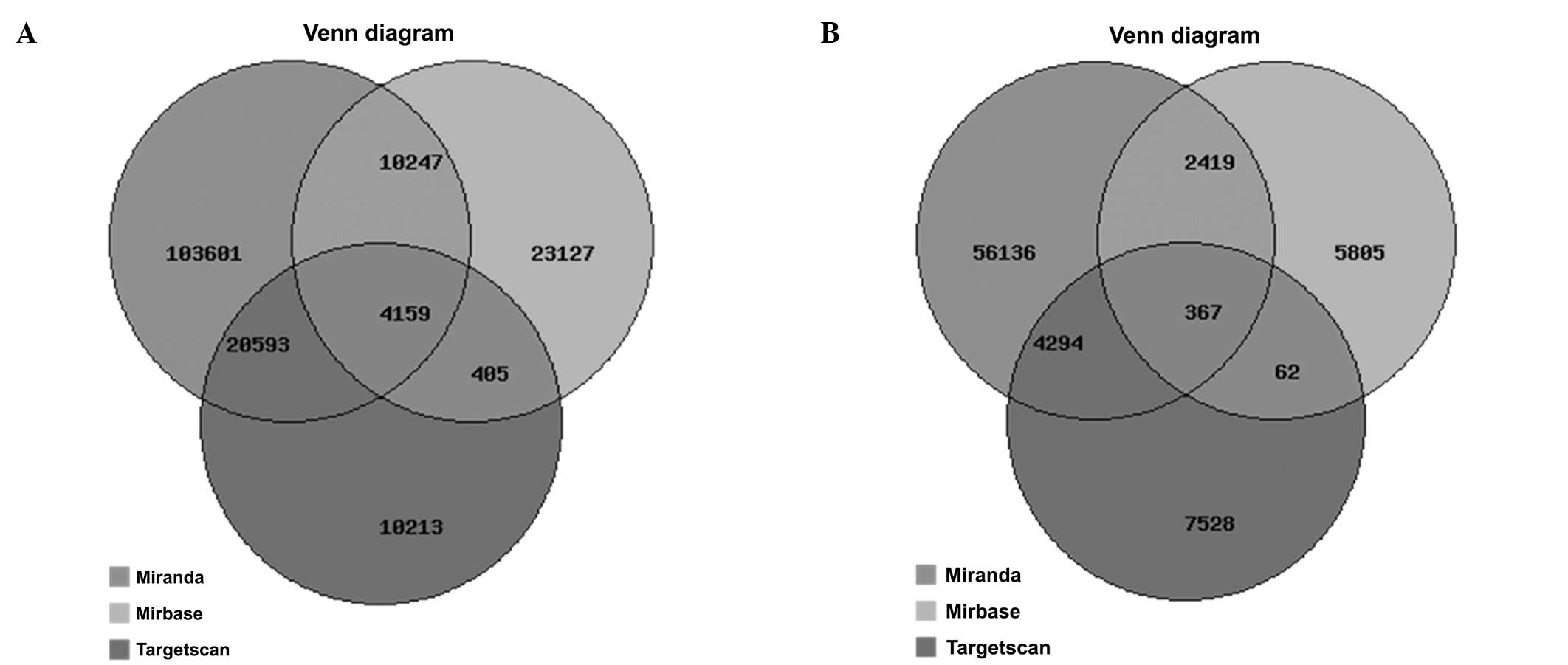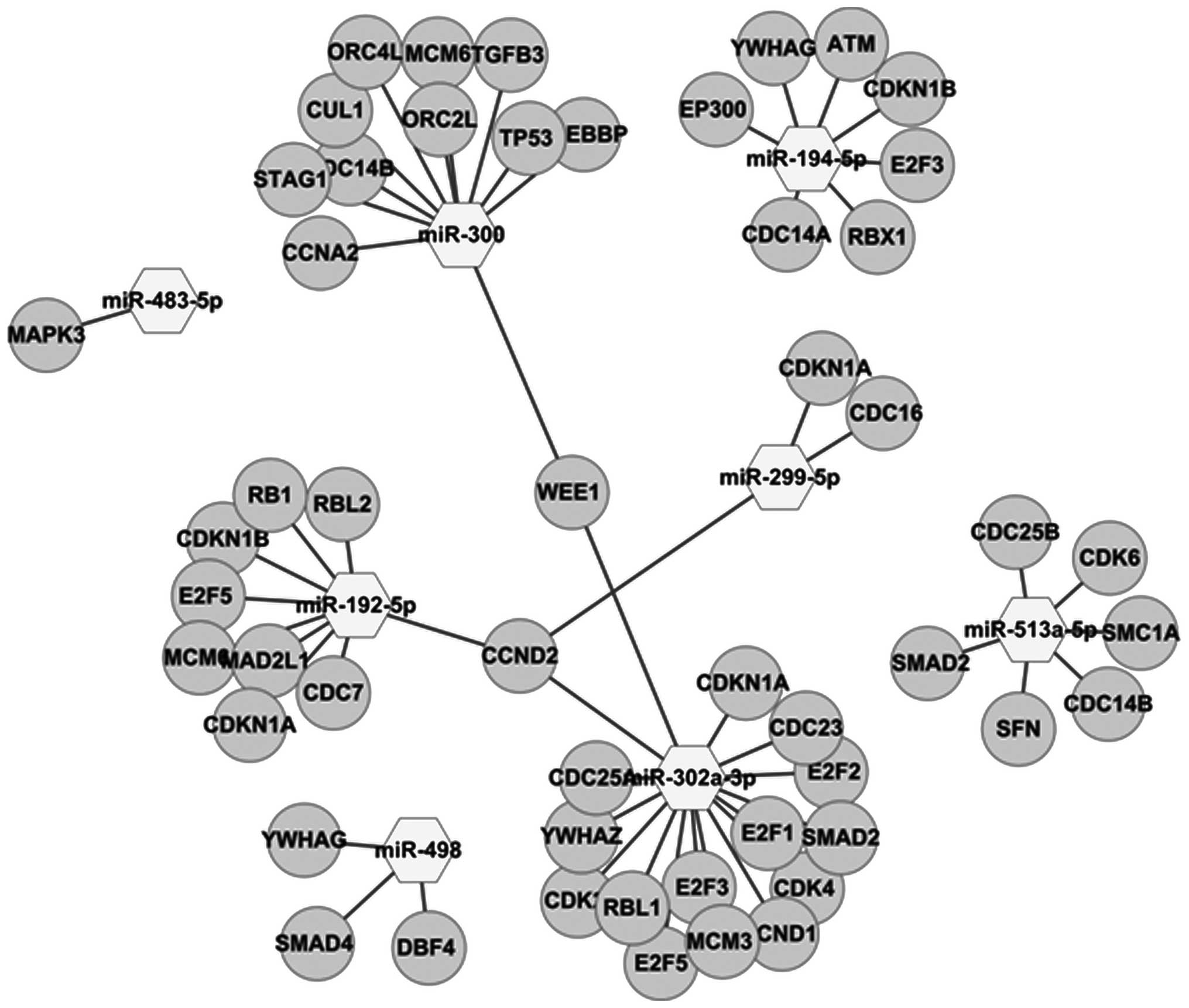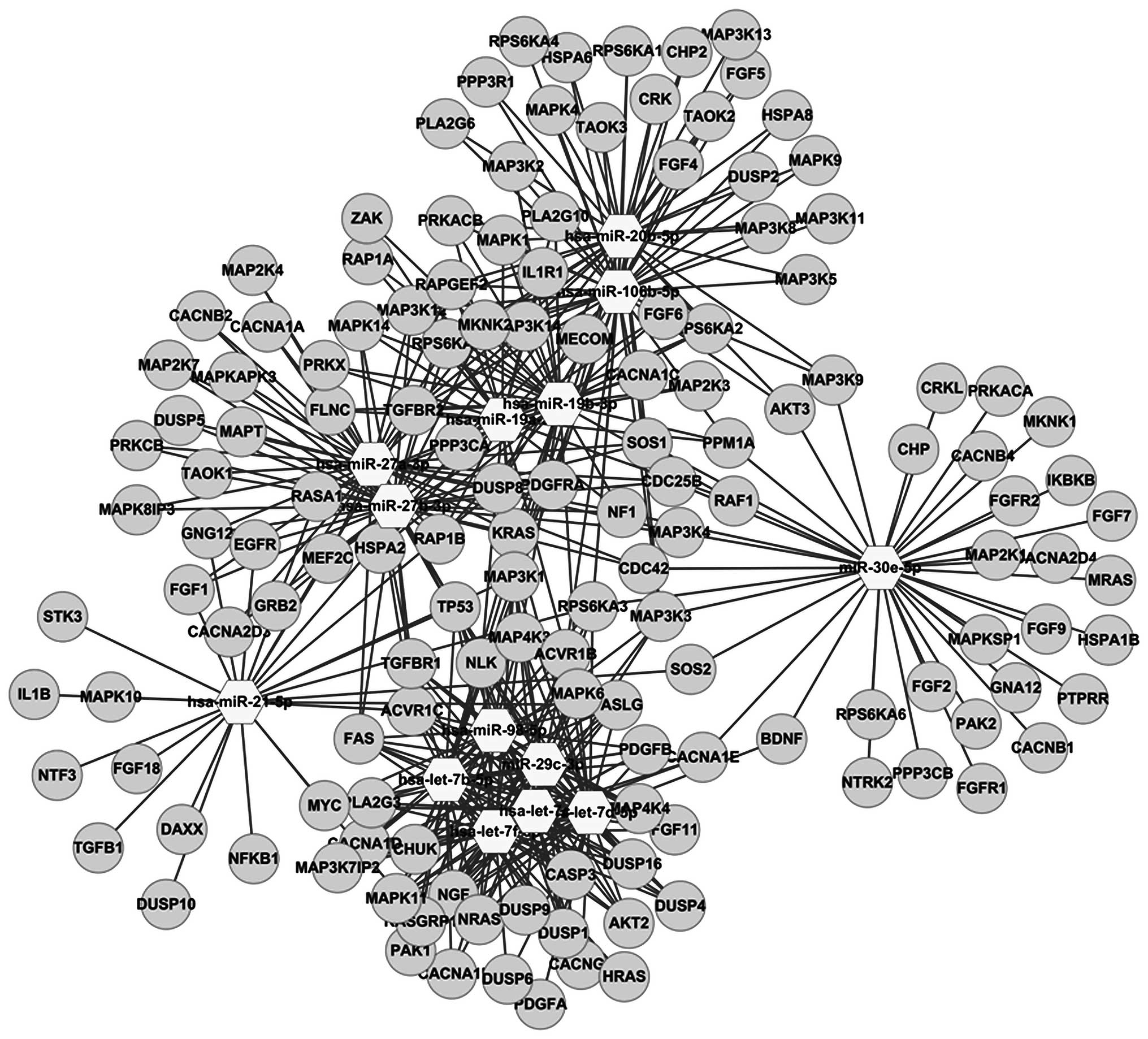Matrine alters microRNA expression profiles in SGC-7901 human gastric cancer cells
- Authors:
- Published online on: August 28, 2014 https://doi.org/10.3892/or.2014.3447
- Pages: 2118-2126
Abstract
Introduction
Matrine is a major alkaloid extracted from Sophora flavescens that has been used clinically in the treatment of gastric cancer. Matrine exhibits antitumor activity in several types of cancer including gastric (1–5), lung cancer (6,7), acute myeloid leukemia (8,9), breast (10), prostate (11), hepatocellular (12), pancreatic (13), colon cancer (14) and gallbladder carcinomas (15). The anticancer properties of matrine are associated with its ability to suppress proliferation and induce apoptosis in tumor cell lines through a variety of different pathways (2,7–10,16). However, in the case of gastric cancer the mechanism of action has yet to be clarified.
Matrine injections have been found to inhibit the migration, invasion and adhesion capacity of SGC-7901 gastric cancer cells in vitro. This inhibition may be correlated with the downregulation of CD44 (V6) protein expression (2). Matrine injections are also able to induce apoptosis of SGC-7901 cells by upregulating Fas/FasL expression and activating caspase-3 (3). Furthermore, matrine can induce apoptosis in MKN45 gastric cancer cells via an increase in pro-apoptotic molecules from the Bcl-2 family (5). Matrine has been found to modulate NF-κB, XIAP, CIAP and p-ERK protein expression in the MNK45 cell line, resulting in antitumor effects (4). In addition, matrine inhibits the adhesion and migration of BGC823 gastric cancer cells by affecting the structure and function of the vasodilator-stimulated phosphoprotein (VASP) (17).
It has recently been reported that matrine suppresses breast cancer by downregulating miR-21, leading to the dephosphorylation of Akt and resulting in an accumulation of Bad, p21(/WAF1/CIP1) and p27(/KIP1) (10). Thus, miRNA may act as a mediator, contributing to the therapeutic efficacy of matrine. The aim of the present study was to examine the effects of matrine on miRNA expression profiles of the SGC7901 gastric cancer cell line and to identify the putative target genes by analyzing differentially expressed miRNAs and the enrichment pathways of target genes. To the best of our knowledge, this is the first study to examine the effect of treatment with matrine on miRNA expression profiles in gastric cancer cells.
Materials and methods
Cell line and cell culture
The SGC7901 cell line was obtained from the Cancer Institute and Hospital, Chinese Academy of Medical Sciences (CAMS) (Beijing, China). The cells were grown in 90% RPMI-1640, supplemented with 10% FBS, 100 U/ml penicillin, and 100 mg/ml streptomycin and incubated at 37°C in a humidified atmosphere of 5% CO2.
Matrine treatment
Matrine (Baoji Fangsheng Pharmaceutical Co., Ltd., Xian, China) was analyzed by HPLC assay and dissolved in phosphate-buffered saline (PBS; Invitrogen-Gibco, Grand Island, NY, USA). SGC-7901 cell cultures were then treated for 24 h with 0.5, 1.0, 1.5, 2.0 and 2.5 mg/ml concentrations of matrine. Subsequently, 20 μl of 5 mg/ml MTT in PBS was added to each well and the plate was incubated at 37°C for 4 h. The plate was then centrifuged at 1,000 × g for 2 min and followed by removal of the medium. One-hundred and fifty microliter of dimethyl sulfoxide (DMSO; Sigma, St. Louis, MO, USA) was then added. After incubation at 37°C for 5 min, absorbance in the control and matrine-treated cells was measured spectrophotometrically at 570 nm using a benchmark microtiter plate reader (Bio-Rad Laboratories, Hercules, CA, USA). Microarray array was subsequently conducted on the control (blank) vs. 1.5 mg/ml matrine (MA) treatment groups.
miRNA microarray analysis
Total RNA, including miRNA, was isolated using the miRNeasy mini kit (Qiagen, Hilgen, Germany), according to the manufacturer’s instructions. RNA quality and quantity was measured via a NanoDrop spectrophotometer (ND-1000; NanoDrop Technologies, Wilmington, DE, USA) and RNA integrity was determined by gel electrophoresis. The concentration and purity of total RNA were assessed at absorbance readings of 260 and 280 nm, using an ultraviolet spectrophotometer. Only the RNA samples with ratios of A260/A280 >1.8 were used in the present study. After isolating the RNA, the miRCURY Hy3™/Hy5™ Power labeling kit (Exiqon, Copenhagen, Denmark) was used for miRNA labeling, according to the manufacturer’s instructions. One microgram of each sample was 3′-end-labeled with a Hy3™ fluorescent label using T4 RNA ligase, as follows: RNA was placed in 2.0 μl of water and combined with 1.0 μl of CIP buffer and CIP (Exiqon, Vedbaek, Denmark). After incubating for 30 min at 37°C the reaction was terminated by 5-min incubation at 95°C. A volume of 3.0 μl labeling buffer, 1.5 μl fluorescent label (Hy3™), 2.0 μl DMSO, and 2.0 μl labeling enzyme were then added. The mixture was incubated for 1 h at 16°C for labeling, followed by 15-min incubation at 65°C to terminate the labeling reaction. After labeling, the Hy3™-labeled samples were hybridized on the miRCURY™ LNA Array v.18.0 (Exiqon, Copenhagen, Denmark), according to the array manual. A 25 μl volume of the Hy3™-labeled sample mixture and 25 μl hybridization buffer were denatured for 2 min at 95°C, incubated on ice for 2 min and then hybridized to the microarray for 16–20 h at 56°C in a 12-Bay hybridization system (NimbleGen Hybridization System 12; Roche Applied Science, Madison, WI, USA), which provides an active mixing action and constant incubation temperature to improve hybridization uniformity and signal enhancement. Following hybridization, slides were prepared, washed several times using a wash buffer kit (Exiqon), and dried via centrifugation for 5 min at 400 rpm. The slides were scanned using an Axon GenePix 4000B microarray scanner (Axon Instruments, Foster City, CA, USA).
miRNA target gene prediction and signaling pathway analyses
miRBase, miRanda and TargetScan were used to predict the target genes of differentially expressed miRNAs following matrine treatment. The prediction information from the three databases that overlapped was considered the final result. The miRNA target gene prediction databases miRFocus 2.0 (http://mirfocus.org/index.php) and miRWalk (http://www.umm.uni-heidelberg.de/apps/zmf/mirwalk/) were also used to analyze plausible KEGG pathway enrichment of dysregulated miRNA targets. The miRFocus 2.0 prediction tools included miRanda, MirTarget2, PicTar, microT and TargetScanS. The experimental validated target gene tools included miRecords, miR2Disease, TarBase and miRTarBase. The prediction databases support number was ≥3 and the Fisher test P-value cut-off was 0.01.
miRNA quantification by RT-qPCR
A SYBR-Green RT-PCR assay was used for miRNA quantification. In brief, 1 μg of total RNA, containing miRNA, was polyadenylated using poly(A) polymerase and was reverse transcribed to cDNA using a miScript Reverse Transcription kit, according to the manufacturer’s instructions (GeneCopoeia, Rockville, MD, USA). The miScript Universal primer was provided by the manufacturer (GeneCopoeia) and the miScript SYBR-Green PCR kit was used. RT-PCR was performed using the Bio-Rad CFX96 real-time PCR system. Each reaction was performed in a final volume of 10 μl containing 2 μl cDNA, 0.5 mM of each primer and 1X SYBR-Green PCR Master Mix (GeneCopoeia). The amplification program was as follows: denaturation at 95°C for 10 min, followed by 45 cycles at 94°C for 15 sec, 55°C for 30 sec and 70°C for 30 sec, in which fluorescence was obtained. After completion of the PCR cycles melting curve analyses and electrophoresis, on 2.5% agarose gels were performed to validate the specificity of the expected PCR product. Each sample was analyzed in triplicate. The expression levels of miRNAs were normalized to RNU6B and the relative gene expression was calculated as 2−(CTmiRNA-CTRNU6B RNA). Each sample was analyzed in triplicate. All the miRNA PCR primers were purchased from GeneCopoeia.
Statistical analysis
Scanned images of the miRNA Array were imported into GenePix Pro 6.0 software (Axon) for grid alignment and data extraction. Replicated miRNAs were averaged and miRNAs with intensities of ≥50 in all the samples were used to calculate the normalization factor. Expressed data were normalized using the Median normalization. After normalization, differentially expressed miRNAs were identified through fold change filtering. Hierarchical clustering was performed using MeV software (v4.9, TIGR). Results of real-time RT-PCR experiments are expressed as means ± SD.
Results
MTT results
The antitumor reducing activity of matrine cytotoxicity (0.5, 1.0, 1.5, 2.0 and 2.5 mg/ml) to SGC-7901 cells culture is shown in Fig. 1. Matrine showed a dose-dependent inhibition of the growth of SGC-7901 cells.
Effects of matrine on miRNA expression profiling of SGC-7901 gastric cancer cells
After SGC-7901 cells were treated with 1.5 mg/ml matrine for 24 h, 60 miRNAs were downregulated (fold change, ≤0.5) and 68 miRNAs were upregulated (fold change, ≥2.0) (Fig. 2). By searching the miRFocus 2.0 and miRWalk miRNA databases, only 38 of the 60 downregulated miRNAs and 8 of 68 upregulated miRNAs were annotated with their respective expressions in cancer tissues or cells or the predicted and validated target genes. Of the 46 annotated miRNAs, 25 were upregulated and 6 were downregulated in gastric cancer tissue or gastric cancer cell lines by miRNA microarray or RT-PCR (Tables I–III).
Table IExpression of 8 upregulated miRNAs altered by microarray experiment and RT-qPCR experiment validation after matrine treatment (1.50 mg/ml). |
Table IIIMatrine-regulated miRNAs and the related documentation of expression in gastric cancer tissue or gastric cancer cell lines identified by microarray analysis or RT-qPCR experiments. |
Signaling pathway analyses of differentially expressed miRNA target genes
The miRBase, miRanda and TargetScan bioinformatical databases were used to predict the target genes of 46 aberrantly expressed miRNAs. The results showed that there are 4,159 overlapped target genes as predicted by the three tools for all the downregulated miRNAs and 367 overlapped target genes for the upregulated miRNAs that exhibited a >2-fold expression change after matrine treatment (Fig. 3). Possible regulation mechanisms of differentially expressed miRNAs following matrine treatment were investigated using the bioinformatics database, miRFocus 2.0, to select clustered enrichment KEGG pathways of plausible targets for each miRNA. A total of 57 enrichment pathways for predicted target genes were identified, including 36 enrichment signaling pathways for downregulated miRNAs. According to the Enrichment Score, the top 10 signaling pathways were the MAPK, focal adhesion, neurotrophin, axon guidance, ECM-receptor interaction, Wnt, amino sugar and nucleotide sugar metabolism, glycosaminoglycan biosynthesis-keratan sulfate, and the p53 signaling pathway, as well as pathways in cancer (Table IV).
Table IVEnrichment KEGG pathway analysis of downregulated miRNA target genes after matrine treatment. |
The remaining 21 enrichment signaling pathways were associated with the target genes of upregulated miRNAs. According to the Enrichment Score, the top 10 signaling pathways were the Legionellosis, notch, neurotrophin, protein processing in endoplasmic reticulum, TGF-β, small cell lung cancer, epithelial cell signaling in Helicobacter pylori infection, cell cycle, RIG-I-like and pertussis signaling pathways (Table V).
The miRFocus 2.0 database was thoroughly examined for target genes of pathways for MAPK signaling and cell cycles. The results showed that 196 genes are associated with MAPK signaling pathways regulated by the 14 downregulated miRNAs, while 53 genes are associated with cell cycle pathways regulated by the 8 upregulated miRNAs. In this study, of the 159 genes 14 miRNAs were downregulated (Figs. 4 and 5).
Quantification of dysregulated miRNAs whose target genes are clustered in MAPK signaling pathway and cell cycle by RT-qPCR
After SGC-7901 cells were treated with 1.5 mg/ml matrine for 24 h, 14 miRNAs whose target genes were clustered in the MAPK signaling pathway and 8 miRNAs whose target genes are clustered in pathways of the cell cycle were selected to verify their expression using RT-qPCR. The results showed the alterations of 8 upregulated miRNAs, including miR-192-5p, miR-299-5p, miR-194-5p, miR-300, miR-302a-3p, miR-483-5p, miR-498 and miR-513a-5p whose target genes were clustered in the cell cycle pathway following matrine treatment (1.5 mg/ml), were consistent with alterations identified by miRNA microarray. However, for the 38 down-regulated miRNAs, the alterations of 14 miRNAs following matrine treatment (1.5 mg/ml), including let-7b-5p, let-7c, let-7d-5p, let-7f-5p, miR-19a-3p, miR-19b-3p, miR-20b-5p, miR-21-5p, miR-27a-3p, miR-27b-3p, miR-29c-3p, miR-30e-5p, miR-98-5p and miR-106b-5p whose target genes were clustered in the MAPK signaling pathway, were consistent with alterations identified by miRNA microarray (Tables I and II).
Table IIExpression of 14 downregulated miRNAs altered by microarray experiment and qRT-PCR experiment validation after matrine treatment (1.50 mg/ml). |
Discussion
Based on the miRNA microarray analysis, 128 miRNAs with differential expression were identified after 24 h of treatment with 1.5 mg/ml matrine. Of these, 68 were upregulated and 60 were downregulated following matrine treatment. The functions of 8 of the upregulated miRNAs and 38 of the downregulated miRNAs have been annotated with their target genes in the miRbase miRNA database. Of these 46 differentially expressed miRNAs with annotations, results of RT-qPCR showed that 8 miRNAs whose target genes were clustered in the cell cycle pathway were upregulated after matrine treatment, while 14 miRNAs whose target genes were clustered in the MAPK signaling pathway were downregulated after matrine treatment.
The majority of the miRNAs that were affected by matrine treatment were associated with the pathogenesis and development of human gastric cancers. Of the 38 miRNAs that were downregulated after matrine treatment, 20 were upregulated in human gastric cancers and gastric cancer cell lines and act as oncogenes. These include let-7b-5p, miR-10a-5p, miR-15b-5p, miR-18a-5p, miR-18b-5p, miR-19a-3p, miR-19b-3p, miR-20b-5p, miR-21-5p, miR-23a-3p, miR-26b-5p, miR-27a-3p, miR-27b-3p, miR-32-5p, miR-34a-5p, miR-98, miR-106b-5p, miR-181a-5p, miR-183-5p and miR-338-3p. Notably, matrine upregulated 5 miRNAs that have been reported to be elevated in human gastric cancers and gastric cancer cell lines. These include let-7a-5p, miR-192-5p, miR-194-5p, miR-335-5p and miR-424-5p. In addition, matrine downregulated 6 miRNAs that have been reported to be reduced in human gastric cancers and gastric cancer cell lines. These include miR-29b-3p, miR-29c-3p, miR-30e-5p, miR-130a-3p, 130b-3p and 148b-3p (Table III) (7–34). Bioinformatical analysis of differentially expressed miRNAs revealed that the target genes were associated with cancer and cell cycle pathways, as well as the MAPK, p53, TGF-β, mTOR, Wnt and notch signaling pathways, which are involved in tumorigenesis. The 8 upregulated miRNAs and 14 downregulated miRNAs, in particular, are involved in the cell cycle and MAPK signaling pathways and were found to be regulated by matrine. Thus, gastric, as well as other cancer cells may be mediated by miRNAs.
Since matrine promotes the apoptosis of Raji cells by activated p38MAPK (46), it suppressed the activity of ERK and increased the activities of p38 and JNK when inhibiting the proliferation of the U937 cell line, inducing apoptosis in vitro (47). Furthermore, matrine inhibited the migration of HUVECs induced by A549 by suppressing MAPK/ERK signaling transduction (47). In addition, matrine has been reported to reduce the percentage of cells in the G2/M phase, and increase the percentage of cells arrested in the G0/G1 phase of the cell cycle, resulting in blocking of the cell cycle at the G0/G1 stage when treating cancer cells, such as human SGC-7901 gastric cancer cell line (1), HT29 colon cancer cell line (14), human rhabdomyosarcoma cells (48), PC-3 prostate cancer cell line (11), HepG2 human hepatoma cell line (12), human A549 adenocarcinoma lung cancer cell line (49) and the human K562 leukemia cell line (50). Therefore, the aberrantly expressed miRNAs whose target genes were clustered in the MAPK signaling pathway and pathways selected for analysis of their predicted and validated target genes by miRFocus 2.0 and miRWalk provide further explanations of the underlying mechanism of action and mechanisms involved in the SGC-7901 gastric cancer cell line following matrine treatment.
Putative target miRNAs, along with target genes and enriched KEGG pathways identified through analysis and validation of the differentially expressed miRNAs in human SGC-7901 gastric cancer cells that had been treated with matrine has facilitated the possibility of finding the target of natural, chemopreventive agents. This may provide insight into the antitumor mechanism of action of matrine, particularly in the case of gastric cancer. In recent years, there have been several reports of miRNA regulation via natural, non-toxic, chemopreventive agents, including curcumin, resveratrol, isoflavones, (−)-epigallocatechin-3-gallate (EGCG), lycopene, 3,3′-diindolylmethane (DIM) and indole-3-carbinol (I3C) (51,52). Thus, natural agents, including matrine, may inhibit cancer progression, increase drug sensitivity, reverse epithelial-mesenchymal transition (EMT), and prevent metastasis though the modulation of miRNAs, providing promising new therapies for the treatment of cancer.
In conclusion, matrine affects miRNA expression in the SGC-7901 gastric cancer cell line as evidenced by miRNA microarray and analysis of differentially expressed miRNA target genes and enrichment pathways. These results, combined with RT-qPCR validation and bioinformatical analyses, provide a novel and promising approach to identify targets for matrine and/or other natural substances, when treating cancer.
Acknowledgements
We would like to thank KangChen Bio-teck (Shanghai, China) for microarray experiments. The present study was supported by the Key Laboratory of TCM Pharmacology and Toxicology of Gansu Province under the Grant Open Plan (no: ZDSYS-KJ-2012-003, ZDSYS-KJ-2013-009).
References
|
Zhang J, Li Y, Chen X, et al: Autophagy is involved in anticancer effects of matrine on SGC-7901 human gastric cancer cells. Oncol Rep. 26:115–124. 2011.PubMed/NCBI | |
|
Dai ZJ, Gao J, Ji ZZ, et al: Matrine induces apoptosis in gastric carcinoma cells via alteration of Fas/FasL and activation of caspase-3. J Ethnopharmacol. 123:91–96. 2009. View Article : Google Scholar : PubMed/NCBI | |
|
Dai ZJ, Gao J, Wu WY, et al: [Effect of matrine injections on invasion and metastasis of gastric carcinoma SGC-7901 cells in vitro]. Zhong Yao Cai. 30:815–819. 2007. | |
|
Luo C, Zhong HJ, Zhu LM, et al: Inhibition of matrine against gastric cancer cell line MNK45 growth and its anti-tumor mechanism. Mol Biol Rep. 39:5459–5464. 2012. View Article : Google Scholar : PubMed/NCBI | |
|
Luo C, Zhu Y, Jiang T, et al: Matrine induced gastric cancer MKN45 cells apoptosis via increasing pro-apoptotic molecules of Bcl-2 family. Toxicology. 229:245–252. 2007. View Article : Google Scholar : PubMed/NCBI | |
|
Liu YQ, Li Y, Qin J, et al: Matrine reduces proliferation of human lung cancer cells by inducing apoptosis and changing miRNA expression profiles. Asian Pac J Cancer Prev. 15:2169–2177. 2014. View Article : Google Scholar : PubMed/NCBI | |
|
Niu H, Zhang Y, Wu B, Zhang Y, Jiang H and He P: Matrine induces the apoptosis of lung cancer cells through downregulation of inhibitor of apoptosis proteins and the Akt signaling pathway. Oncol Rep. 2014. View Article : Google Scholar : PubMed/NCBI | |
|
Jiang H, Hou C, Zhang S, et al: Matrine upregulates the cell cycle protein E2F-1 and triggers apoptosis via the mitochondrial pathway in K562 cells. Eur J Pharmacol. 559:98–108. 2007. View Article : Google Scholar : PubMed/NCBI | |
|
Zhang S, Zhang Y, Zhuang Y, et al: Matrine induces apoptosis in human acute myeloid leukemia cells via the mitochondrial pathway and Akt inactivation. PLoS One. 7:e468532012. View Article : Google Scholar : PubMed/NCBI | |
|
Li LQ, Li XL, Wang L, et al: Matrine inhibits breast cancer growth via miR-21/PTEN/Akt pathway in MCF-7 cells. Cell Physiol Biochem. 30:631–641. 2012. View Article : Google Scholar : PubMed/NCBI | |
|
Zhang P, Wang Z, Chong T and Ji Z: Matrine inhibits proliferation and induces apoptosis of the androgenindependent prostate cancer cell line PC-3. Mol Med Rep. 5:783–787. 2012.PubMed/NCBI | |
|
Zhang JQ, Li YM, Liu T, et al: Antitumor effect of matrine in human hepatoma G2 cells by inducing apoptosis and autophagy. World J Gastroenterol. 16:4281–4290. 2010. View Article : Google Scholar : PubMed/NCBI | |
|
Liu T, Song Y, Chen H, Pan S and Sun X: Matrine inhibits proliferation and induces apoptosis of pancreatic cancer cells in vitro and in vivo. Biol Pharm Bull. 33:1740–1745. 2010. View Article : Google Scholar : PubMed/NCBI | |
|
Chang C, Liu SP, Fang CH, et al: Effects of matrine on the proliferation of HT29 human colon cancer cells and its antitumor mechanism. Oncol Lett. 6:699–704. 2013.PubMed/NCBI | |
|
Zhang Z, Wang X, Wu W, et al: Effects of matrine on proliferation and apoptosis in gallbladder carcinoma cells (GBC-SD). Phytother Res. 26:932–937. 2012. View Article : Google Scholar : PubMed/NCBI | |
|
Yang Z, Mu J, Chen J, et al: [Apoptosis of U937 cell line promoted by matrine through MAPK signal transduction pathway]. Zhongguo Zhong Yao Za Zhi. 34:1553–1556. 2009. | |
|
Zhang JW, Su K, Shi WT, et al: Matrine inhibits the adhesion and migration of BCG823 gastric cancer cells by affecting the structure and function of the vasodilator-stimulated phosphoprotein (VASP). Acta Pharmacol Sin. 34:1084–1092. 2013. View Article : Google Scholar : PubMed/NCBI | |
|
Ribeiro-dos-Santos A, Khayat AS, Silva A, et al: Ultra-deep sequencing reveals the microRNA expression pattern of the human stomach. PLoS One. 5:e132052010. View Article : Google Scholar : PubMed/NCBI | |
|
Chen W, Tang Z, Sun Y, et al: miRNA expression profile in primary gastric cancers and paired lymph node metastases indicates that miR-10a plays a role in metastasis from primary gastric cancer to lymph nodes. Exp Ther Med. 3:351–356. 2012. | |
|
Tsukamoto Y, Nakada C, Noguchi T, et al: MicroRNA-375 is downregulated in gastric carcinomas and regulates cell survival by targeting PDK1 and 14-3-3zeta. Cancer Res. 70:2339–2349. 2010. View Article : Google Scholar : PubMed/NCBI | |
|
Guo J, Miao Y, Xiao B, et al: Differential expression of microRNA species in human gastric cancer versus non-tumorous tissues. J Gastroenterol Hepatol. 24:652–657. 2009. View Article : Google Scholar : PubMed/NCBI | |
|
Yao Y, Suo AL, Li ZF, et al: MicroRNA profiling of human gastric cancer. Mol Med Rep. 2:963–970. 2009.PubMed/NCBI | |
|
Qin S, Ai F, Ji WF, Rao W, Zhang HC and Yao WJ: miR-19a promotes cell growth and tumorigenesis through targeting SOCS1 in gastric cancer. Asian Pac J Cancer Prev. 14:835–840. 2013. View Article : Google Scholar : PubMed/NCBI | |
|
Ueda T, Volinia S, Okumura H, et al: Relation between microRNA expression and progression and prognosis of gastric cancer: a microRNA expression analysis. Lancet Oncol. 11:136–146. 2010. View Article : Google Scholar : PubMed/NCBI | |
|
Katada T, Ishiguro H, Kuwabara Y, et al: microRNA expression profile in undifferentiated gastric cancer. Int J Oncol. 34:537–542. 2009.PubMed/NCBI | |
|
Li X, Luo F, Li Q, et al: Identification of new aberrantly expressed miRNAs in intestinal-type gastric cancer and its clinical significance. Oncol Rep. 26:1431–1439. 2011.PubMed/NCBI | |
|
Wang HJ, Ruan HJ, He XJ, et al: MicroRNA-101 is down-regulated in gastric cancer and involved in cell migration and invasion. Eur J Cancer. 46:2295–2303. 2010. View Article : Google Scholar : PubMed/NCBI | |
|
Chan SH, Wu CW, Li AF, Chi CW and Lin WC: miR-21 microRNA expression in human gastric carcinomas and its clinical association. Anticancer Res. 28:907–911. 2008.PubMed/NCBI | |
|
Chen Z, Saad R, Jia P, et al: Gastric adenocarcinoma has a unique microRNA signature not present in esophageal adenocarcinoma. Cancer. 119:1985–1993. 2013. View Article : Google Scholar : PubMed/NCBI | |
|
Kim BH, Hong SW, Kim A, Choi SH and Yoon SO: Prognostic implications for high expression of oncogenic microRNAs in advanced gastric carcinoma. J Surg Oncol. 107:505–510. 2013. View Article : Google Scholar : PubMed/NCBI | |
|
Inoue T, Iinuma H, Ogawa E, Inaba T and Fukushima R: Clinicopathological and prognostic significance of microRNA-107 and its relationship to DICER1 mRNA expression in gastric cancer. Oncol Rep. 27:1759–1764. 2012.PubMed/NCBI | |
|
Liu T, Tang H, Lang Y, Liu M and Li X: MicroRNA-27a functions as an oncogene in gastric adenocarcinoma by targeting prohibitin. Cancer Lett. 273:233–242. 2009. View Article : Google Scholar : PubMed/NCBI | |
|
Zhao X, Yang L and Hu J: Down-regulation of miR-27a might inhibit proliferation and drug resistance of gastric cancer cells. J Exp Clin Cancer Res. 30:552011. View Article : Google Scholar : PubMed/NCBI | |
|
Matsuo M, Nakada C, Tsukamoto Y, et al: MiR-29c is downregulated in gastric carcinomas and regulates cell proliferation by targeting RCC2. Mol Cancer. 12:152013. View Article : Google Scholar : PubMed/NCBI | |
|
Saito Y, Suzuki H, Imaeda H, et al: The tumor suppressor microRNA-29c is downregulated and restored by celecoxib in human gastric cancer cells. Int J Cancer. 132:1751–1760. 2013. View Article : Google Scholar : PubMed/NCBI | |
|
Osawa S, Shimada Y, Sekine S, et al: MicroRNA profiling of gastric cancer patients from formalin-fixed paraffin-embedded samples. Oncol Lett. 2:613–619. 2011.PubMed/NCBI | |
|
Song YX, Yue ZY, Wang ZN, et al: MicroRNA-148b is frequently down-regulated in gastric cancer and acts as a tumor suppressor by inhibiting cell proliferation. Mol Cancer. 10:12011. View Article : Google Scholar : PubMed/NCBI | |
|
Chen G, Shen ZL, Wang L, Lv CY, Huang XE and Zhou RP: Hsa-miR-181a-5p expression and effects on cell proliferation in gastric cancer. Asian Pac J Cancer Prev. 14:3871–3875. 2013. View Article : Google Scholar : PubMed/NCBI | |
|
Zhang X, Nie Y, Du Y, Cao J, Shen B and Li Y: MicroRNA-181a promotes gastric cancer by negatively regulating tumor suppressor KLF6. Tumour Biol. 33:1589–1597. 2012. View Article : Google Scholar : PubMed/NCBI | |
|
Carvalho J, van Grieken NC, Pereira PM, et al: Lack of microRNA-101 causes E-cadherin functional deregulation through EZH2 up-regulation in intestinal gastric cancer. J Pathol. 228:31–44. 2012.PubMed/NCBI | |
|
Zhu YM, Zhong ZX and Liu ZM: Relationship between let-7a and gastric mucosa cancerization and its significance. World J Gastroenterol. 16:3325–3329. 2010. View Article : Google Scholar : PubMed/NCBI | |
|
Yang Q, Jie Z, Cao H, et al: Low-level expression of let-7a in gastric cancer and its involvement in tumorigenesis by targeting RAB40C. Carcinogenesis. 32:713–722. 2011. View Article : Google Scholar : PubMed/NCBI | |
|
Zhu Y, Xiao X, Dong L and Liu Z: Investigation and identification of let-7a related functional proteins in gastric carcinoma by proteomics. Anal Cell Pathol (Amst). 35:285–295. 2012. View Article : Google Scholar : PubMed/NCBI | |
|
Chiang Y, Zhou X, Wang Z, et al: Expression levels of microRNA-192 and -215 in gastric carcinoma. Pathol Oncol Res. 18:585–591. 2012. View Article : Google Scholar : PubMed/NCBI | |
|
Song Y, Zhao F, Wang Z, et al: Inverse association between miR-194 expression and tumor invasion in gastric cancer. Ann Surg Oncol. 19(Suppl 3): S509–517. 2012. View Article : Google Scholar : PubMed/NCBI | |
|
Liu ZS, Luo ZQ, Xie B, et al: [Effect and mechanism of matrine on apoptosis of Raji cells]. Zhong Yao Cai. 34:576–579. 2011. | |
|
Lu J, Luo Q, Cheng P, Liu X, Bai M and Tu M: [The Role of Matrine and Mitogen-Ativated Protein Kinase/Extracellular Signal-Regulated Kinase Signal Transduction in the Inhibition of the Proliferation and Migration of Human Umbilical Veins Endothelial Cells Induced by Lung Cancer cells]. Zhongguo Fei Ai Za Zhi. 12:747–752. 2009. | |
|
Guo L, Xue TY, Xu W and Gao JZ: Matrine promotes G0/G1 arrest and down-regulates cyclin D1 expression in human rhabdomyosarcoma cells. Panminerva Med. 55:291–296. 2013.PubMed/NCBI | |
|
Chen Q, Liu L and Cao H: [Effects of matrine on the growth inhibition, c-myc and hTERT protein expression in human adenocarcinoma lung cancer cell line A549]. Zhongguo Fei Ai Za Zhi. 11:559–562. 2008. | |
|
Huang FX, Zhang Y and Wang WJ: [Effects of matrine on cgi-100 gene expression and proliferation in K562 cells]. Zhongguo Shi Yan Xue Ye Xue Za Zhi. 16:525–530. 2008. | |
|
Bae S, Lee EM, Cha HJ, et al: Resveratrol alters microRNA expression profiles in A549 human non-small cell lung cancer cells. Mol Cells. 32:243–249. 2011. View Article : Google Scholar : PubMed/NCBI | |
|
Sethi S, Li Y and Sarkar FH: Regulating miRNA by natural agents as a new strategy for cancer treatment. Curr Drug Targets. 14:1167–1174. 2013. View Article : Google Scholar : PubMed/NCBI |



